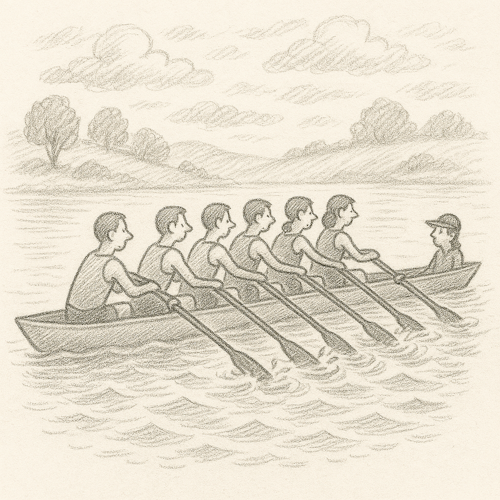The Team of Rowers
Illustrates Alignment, Leadership Focus, Organizational Flow
Agile teams do not succeed by working harder. They succeed by working together, in the same direction, with a shared sense of purpose. Misalignment in goals, structure, or leadership creates friction that no amount of individual effort can overcome. This parable speaks to team dynamics, leadership systems, and the cost of uncoordinated ambition.
Once there was a company that entered a rowing competition. Eager to win, they assembled a team of top performers from different departments. Each rower was highly skilled, motivated, and confident.
On race day, the team launched their boat with great enthusiasm. But as they began to row, something strange happened. The boat spun in circles. It drifted. It lurched forward and stalled again. Despite all their talent and effort, they fell far behind.

The leader called a meeting after the loss.
“We need more discipline,” he said. “Harder work. Longer hours. More training.”
The team practiced relentlessly. New tools were purchased. Consultants were brought in. KPIs were assigned to each rower.
On the next race day, they rowed harder than ever. Muscles strained. Sweat poured. But again, the boat zigzagged wildly, and the result was the same.
Frustrated, one rower finally spoke up. “We are all rowing as hard as we can, but not in the same direction.”
Silence filled the room.
Another said, “We need a shared rhythm. A coxswain. A plan we believe in.”
The team reorganized. They aligned their seats. A clear direction was agreed upon. Roles became visible. A steady cadence replaced chaotic motion.
On the final race, they rowed with less effort but more unity. The boat cut through the water like never before. They didn't just finish. They flew.
Lessons Learned
Effort Without Alignment Is Waste
Many Agile teams suffer not from a lack of drive, but from a lack of direction. Individuals push forward with good intentions but end up working against each other. Without a shared vision and synchronized approach, talent gets squandered.
Coordination Beats Raw Power
In rowing, a team of average athletes who row in sync will often beat a team of stronger individuals pulling out of rhythm. Agile frameworks like Scrum and SAFe are designed to improve cadence, flow, and collaboration. They are not about squeezing more output, but creating smoother delivery.
Leadership Must Set the Rhythm
Rowers need a coxswain to call pace and steer. Agile teams need Product Owners and Scrum Masters to create clarity and hold space for alignment. Leadership is not just about motivation. It is about orchestration.
Visible Roles Reduce Conflict
Part of the team's problem was that no one knew who was steering or setting pace. In organizations, role confusion leads to conflict and rework. Agile ceremonies and artifacts make intentions visible so that decisions can be made together and course corrections happen quickly.
Unity Makes Teams Resilient
Once the rowers found flow, their work became lighter. They conserved energy and built confidence. Aligned teams bounce back from setbacks faster because they trust each other and understand where they are going.
Coaching Tips
- Use This Parable in Retrospectives: Ask teams if they feel like they are rowing together or pulling in different directions. Use the image of the rowboat to surface hidden misalignments.
- Frame Leadership as Navigation, Not Management: Help stakeholders see their role not as micromanagers but as coxswains guiding rhythm and direction. Invite them to remove obstacles rather than add pressure.
- Facilitate Alignment Workshops: Use story mapping, team charters, or OKR sessions to help teams synchronize on vision, goals, and how they will work together.
- Watch for Symptom Drift: If a team is tired but not making progress, look beyond effort. Investigate direction, clarity, and structure. The problem may not be motivation but misalignment.
The Team of Rowers reminds us that no amount of effort can compensate for lack of coordination. Agile teams flourish not by going faster, but by going together. Alignment creates flow. Flow creates results. Coaches, leaders, and team members each play a part in setting the rhythm.
If your team is stuck, ask not how hard they are rowing, but whether they are rowing as one.


